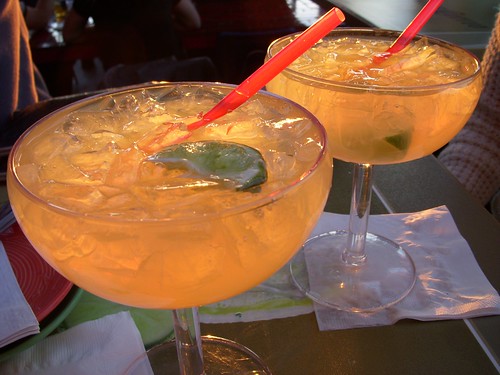February 22nd is National Margarita Day! You know what to do, peoples!
The “margarita” is a cocktail consisting of tequila mixed with triple sec and lime or lemon juice, often served with salt on the glass rim. It is the most common tequila-based cocktail in the United States. The drink is served shaken with ice, on the rocks, blended with ice (frozen margarita) or without ice (straight up).
From wikipedia:
There are many stories about who invented the margarita and why. The following are perhaps the most commonly repeated tales of the creator of the margarita cocktail:
Barman “Willie” from Mexico City, 1934 in the employ of the Melguizo Family. Marguerite Hemery lived in the Rio Grande Valley since the 1930s and went to a restaurant in Matamoros called Los Dos Republicas. She was friends with the owner and, as the story goes, his bartender composed a special drink for her.
Danny Negrete, 1936
Ratios: 1:1:1 (33% tequila, 33% Triple Sec, 33% fresh lime juice).
According to Salvador Negrete, the son of Daniel Negrete, the family story goes that Daniel opened a bar at the Garci Crispo hotel with his brother, David. The day before David’s marriage, Daniel presented the margarita as a wedding present to Margarita, his sister-in-law. It was a combination of one-third Triple Sec, one-third tequila and one-third squeezed Mexican lime juice. The drink was not blended and was served with hand-crushed ice.
Danny Herrera, 1938
In Ensenada, Mexico, Danny Herrera, a renowned Mexican bartender who worked at the Riviera del Pacifico Hotel and Casino was completely in love with Marjorie King, an American actress who hated taking tequila pure. Tequila was also the only liquor that her body could tolerate. Thus, with the intention of wooing her, Herrera used his ingenuity to bring together flavors to meet Marjorie’s tastes, until he finally found one of the world’s most famous drinks.
Rita De La Rosa, 1938
According to Jose Cuervo Margarita Mix, a beautiful showgirl in 1938 named Rita De La Rosa was a bartender and improvised the cocktail.
Don Carlos Orozco, October 1941
He concocted the perfect mixture of equal parts tequila, Damiana (Cointreau is used now) and lime, served over ice in a salt-rimmed glass for Margarita Henkel, daughter of the German Ambassador to Mexico at Hussong’s Cantina
Enrique Bastate Gutierrez, early 1940s
Gutierrez, who lived in Tijuana, Mexico, boasted to have created the Margarita as a homage to actress Rita Hayworth, whose real name was Margarita Cansino. Other versions of the story claim the Margarita was indeed named after the actress, but in the 1930s, before she adopted her screen name. As a teenager, Margarita Cansino worked as a dancer at the Foreign Club, in Tijuana, where she supposedly inspired a bartender.
Francisco “Pancho” Morales, 4 July 1942
A bartender, Pancho Morales invented the margarita on July 4, 1942, at a Ciudad Juárez bar named Tommy’s Place. Supposedly, a woman requested a Magnolia (brandy, Cointreau, and an egg yolk topped with Champagne). Morales was a little fuzzy on the recipe; he improvised and his ersatz creation was a big hit.[2]
Santos Cruz, 1948
According to the promotional flyer for the legendary Balinese Room in Galveston, Texas, head bartender Santos Cruz created the Margarita for singer Peggy (Margaret) Lee in 1948.
The Balinese Room was opened in 1941 and was Texas’s finest nightclub with A/C, casino gambling, superb food and drinks, and stellar entertainment until the Texas Rangers finally shut it down in 1957.
Margaret Sames, December 1948
Ratios: 2:1:1 = 4:2:2 (50% tequila, 25% Cointreau, 25% fresh lime juice).
Sames, who created the drink at her Acapulco bar, gave the reason of being “close with a lot of famous hotel and restaurant people” in introducing the margarita.[3]
Sames used one part Cointreau, two parts tequila and one part lime juice for her margarita. Knowing that most people drank tequila preceded by a lick of salt, she chose to garnish her cocktail with a rim of coarse salt. Sames moved to El Paso, Texas in 1958 where she was well known for her lavish parties.


























